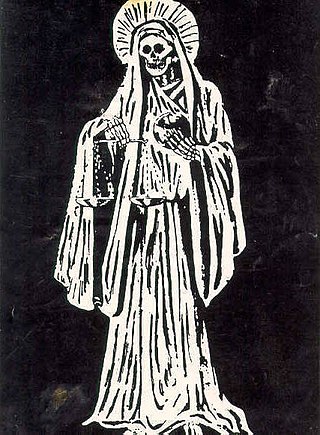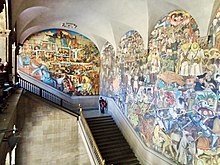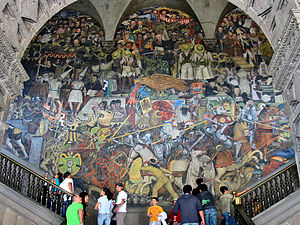
A mural is any piece of graphic artwork that is painted or applied directly to a wall, ceiling or other permanent substrate. Mural techniques include fresco, mosaic, graffiti and marouflage.

Diego María de la Concepción Juan Nepomuceno Estanislao de la Rivera y Barrientos Acosta y Rodríguez, known as Diego Rivera, was a prominent Mexican painter. His large frescoes helped establish the mural movement in Mexican and international art.

Magdalena Carmen Frida Kahlo y Calderón was a Mexican painter known for her many portraits, self-portraits, and works inspired by the nature and artifacts of Mexico. Inspired by the country's popular culture, she employed a naïve folk art style to explore questions of identity, postcolonialism, gender, class, and race in Mexican society. Her paintings often had strong autobiographical elements and mixed realism with fantasy. In addition to belonging to the post-revolutionary Mexicayotl movement, which sought to define a Mexican identity, Kahlo has been described as a surrealist or magical realist. She is also known for painting about her experience of chronic pain.

José Clemente Orozco was a Mexican caricaturist and painter, who specialized in political murals that established the Mexican Mural Renaissance together with murals by Diego Rivera, David Alfaro Siqueiros, and others. Orozco was the most complex of the Mexican muralists, fond of the theme of human suffering, but less realistic and more fascinated by machines than Rivera. Mostly influenced by Symbolism, he was also a genre painter and lithographer. Between 1922 and 1948, Orozco painted murals in Mexico City, Orizaba, Claremont, California, New York City, Hanover, New Hampshire, Guadalajara, Jalisco, and Jiquilpan, Michoacán. His drawings and paintings are exhibited by the Carrillo Gil Museum in Mexico City, and the Orozco Workshop-Museum in Guadalajara. Orozco was known for being a politically committed artist, and he promoted the political causes of peasants and workers.

The Polyforum Cultural Siqueiros is a cultural, political and social facility located in Mexico City as part of the World Trade Center Mexico City. It was designed and decorated by David Alfaro Siqueiros in the 1960s and hosts the largest mural work in the world called La Marcha de la Humanidad. The building has a theatre, galleries and more, but the main focus is the Forum Universal, which contains the interior portion of Siqueiros' mural work. Visitors can experience the mural while standing on a rotating stage, listening to Siqueiros narrate.

La Calavera Catrina ("The Dapper [female] Skull") had its origin as a zinc etching created by the Mexican printmaker and lithographer José Guadalupe Posada (1852-1913) around 1910. It was first published posthumously in 1913 in a satiric broadside as a photo-relief etching. This image of a female skull with a large hat appeared in at least four broadsides, accompanied by different satiric texts.

The National Palace is the seat of the federal executive in Mexico. Since 2018 it has also served as the official residence for the President of Mexico. It is located on Mexico City's main square, the Plaza de la Constitución. This site has been a palace for the ruling class of Mexico since the Aztec Empire, and much of the current palace's building materials are from the original one that belonged to the 16th-century leader Moctezuma II.

Skull art is found in various cultures of the world.

The Detroit Industry Murals (1932–1933) are a series of frescoes by the Mexican artist Diego Rivera, consisting of twenty-seven panels depicting industry at the Ford Motor Company and in Detroit. Together they surround the interior Rivera Court in the Detroit Institute of Arts. Painted between 1932 and 1933, they were considered by Rivera to be his most successful work. On April 23, 2014, the Detroit Industry Murals were designated by the Department of Interior as a National Historic Landmark.

Mexican Muralism refers to the art project initially funded by the Mexican government in the immediate wake of the Mexican Revolution (1910-1920) to depict visions of Mexico's past, present, and future, transforming the walls of many public buildings into didactic scenes designed to reshape Mexicans' understanding of the nation's history. The murals, large artworks painted onto the walls themselves had social, political, and historical messages. Beginning in the 1920s, the muralist project was headed by a group of artists known as "The Big Three" or "The Three Greats". This group was composed of Diego Rivera, José Clemente Orozco and David Alfaro Siqueiros. Although not as prominent as the Big Three, women also created murals in Mexico. From the 1920s to the 1970s, many murals with nationalistic, social and political messages were created in many public settings such as chapels, schools, government buildings, and much more. The popularity of the Mexican muralist project started a tradition which continues to this day in Mexico; a tradition that has had a significant impact in other parts of the Americas, including the United States, where it served as inspiration for the Chicano art movement.
Fanny Rabel, born Fanny Rabinovich, was a Polish-born Mexican artist who is considered to be the first modern female muralist and one of the youngest associated with the Mexican muralism of the early to mid 20th century. She and her family arrived to Mexico in 1938 from Europe and she studied art at the Escuela Nacional de Pintura, Escultura y Grabado "La Esmeralda", where she met and became friends with Frida Kahlo. She became the only female member of “Los Fridos” a group of students under Kahlo’s tutelage. She also worked as an assistant and apprentice to Diego Rivera and David Alfaro Siqueiros, painting a number of murals of her own during her career. The most significant of these is "Ronda en el tiempo" at the Museo Nacional de Antropología in Mexico City. She also created canvases and other works, with children often featured in her work, and was one of the first of her generation to work with ecological themes in a series of works begun in 1979.

Various types of visual arts developed in the geographical area now known as Mexico. The development of these arts roughly follows the history of Mexico, divided into the prehispanic Mesoamerican era, the colonial period, with the period after Mexican War of Independence, the development Mexican national identity through art in the nineteenth century, and the florescence of modern Mexican art after the Mexican Revolution (1910-1920).
Pan American Unity is a mural painted by Mexican artist and muralist Diego Rivera for the Art in Action exhibition at Treasure Island's Golden Gate International Exposition (GGIE) in San Francisco, California in 1940. This work was the centerpiece of the Art In Action exhibit, which featured many different artists engaged in creating works during the Exposition while the public watched.

Sueño de una tarde dominical en la Alameda Central or Dream of a Sunday Afternoon at Alameda Central Park is a 15.6 meter wide mural created by Diego Rivera. It was painted between the years 1946 and 1947, and is the principal work of the Museo Mural Diego Rivera adjacent to the Alameda in the historic center of Mexico City.

The Epic of American Civilization is a mural by the social realist painter José Clemente Orozco. It is located in the basement reading room of the Baker Memorial Library on the campus of Dartmouth College in Hanover, New Hampshire. The mural, painted between 1932 and 1934, consists of a series of 24 fresco panels, whose principal themes are the impact of both indigenous Native Americans and European colonists on North America, and the impact of war and rapid industrialization on the human spirit.

Zapata (1932) is a lithograph by the Mexican artist Diego Rivera (1886–1957) that depicts the Mexican revolutionary Emiliano Zapata (1879–1919) as he holds the reins of a horse among a group of campesinos (peasants). The lithographic edition was created and printed twelve years after Zapata's assassination. Zapata is based on Agrarian Leader Zapata (1931), one of eight "portable" frescoes produced explicitly for Rivera's solo exhibition at the Museum of Modern Art (MoMA) in 1931, which was adapted from his previous Revolt panel from a fresco titled The History of Cuernavaca and Morelos (1929–30) painted in the Palace of Cortés, Cuernavaca. There were 100 original prints of the lithograph, many of which are in the collections of various art museums.
Cristina Kahlo y Calderón (1908–1964) was the sister of artist Frida Kahlo. Frida painted a portrait of Cristina, titled Portrait of Cristina, My Sister, and Diego Rivera, Frida's husband, also portrayed Cristina Kahlo in his work. Cristina, with whom Rivera had an affair, was painted by Rivera in the nude.

History of Morelos, Conquest and Revolution (1929–1930) was a fresco painted by Mexican artist Diego Rivera in Cuernavaca's Palace of Cortés. The piece was commissioned by Dwight Morrow, U.S. Ambassador to Mexico at the time.
La Memoria De Nuestra Tierra: California 1996 is a 10 ft x 30 ft rectangular mural, currently located in the University of Southern California's Graduate Student Lounge within the Ronald Tutor Campus Center. The mural was painted by artist Judy Baca in collaboration with students from the University's Roski School of Art and Design. This piece shows the Chicano history of Southern California through the depiction of various images inspired by the native history of the land and the more modern conflicts and issues Latinos have suffered.
















